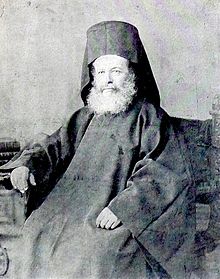Germanus V of Constantinople
This article has multiple issues. Please help improve it or discuss these issues on the talk page. (Learn how and when to remove these messages)
|
Germanus V of Constantinople | |
|---|---|
| Ecumenical Patriarch of Constantinople | |
 | |
| Church | Church of Constantinople |
| In office | 10 February 1913 – 25 October 1918 |
| Predecessor | Joachim III of Constantinople |
| Successor | Meletius IV of Constantinople |
| Personal details | |
| Born | 6 December 1835 |
| Died | 28 July 1920 (aged 84) |
Germanus V (6 December 1835 – 28 July 1920) was the Ecumenical Patriarch of Constantinople from 28 January 1913 till 1918. He was educated in Jerusalem and Athens before attending the Theological School of Halki. Germain V of Constantinople (in Greek Γερμανός Ε ', born December 6, 1835 in Balata du Phanar in Constantinople under the name Georges Kavakopoulos and died July 18, 1920) is patriarch of Constantinople from February 10, 1913 to October 25, 1918.
Germain V is the author of an encyclical published in 1920 as a milestone for the ecumenical movement. He evokes the notion of a "fraternity of churches" to be created, a "blessed union" of the churches for which he invites different traditions to contribute by engaging in the joint study of the essential questions around the notion of meeting.
1. For the Patriarch, the promotion of contacts between the Churches is the first essential step that must be followed by "the abolition of all mutual mistrust and bitterness" so that "the love [is] revived and strengthened between the churches".
2. It then lists eleven basic points as a working proposal for future collaboration between the churches, a list that becomes the basis for the programmatic work of the World Council of Churches at the time of its creation in 1948, which will make Willem Vissert Hooft, first secretary of the WCC, that the "encyclical of 1920 rang the bell of our congregation.
He was elected Metropolitan of Kos (1867), Rhodes (1876-1888), Iraklia (1888-1897) and Chalkedon (1897-1913). On 28 January 1913, the Ecumenical Patriarch was elected.
He was one of the pioneers, in the years 1886–1897, of the efforts for the return of the exiled Patriarch Ioakim III of the Magnificent. On October 7, 1918, a great rebellion against the Orthodox came and was condemned within the Patriarchal Church. He was forced to resign from the throne on October 12, 1918, retiring to Kadikoy, where he died and was buried in December 1920. He was the last Patriarch who received the imperial veranda, the state's recognition of the Sultan.
